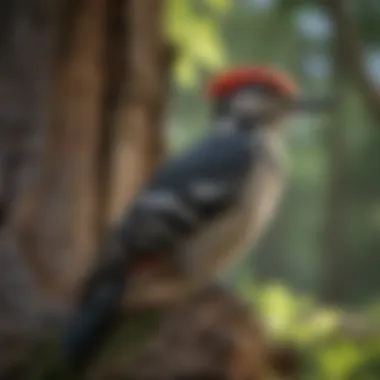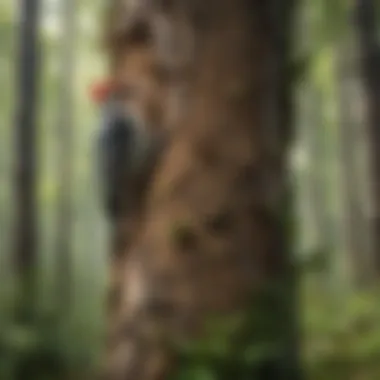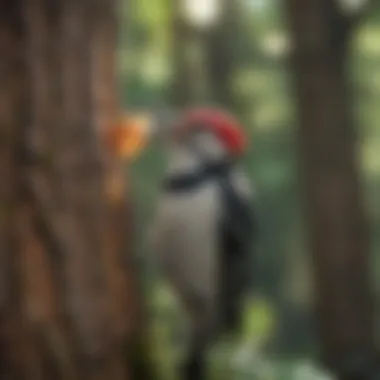Exploring Woodpecker Habitat: Ecology and Conservation


Intro
Understanding woodpecker habitat involves more than just knowing where these birds reside. It encompasses their intricate relationship with the forest ecosystems they inhabit. Woodpeckers play a vital role in the health of woodlands through their foraging and nesting behaviors. Their presence can indicate the overall well-being of an ecosystem, making it important to analyze the factors that influence their habitat selection. In this examination, we will explore the ecological requirements of woodpeckers, their geographic distributions, and the significant impacts that environmental changes have on their populations.
Forest Ecology and Biodiversity
Importance of Forest Ecosystems
Forest ecosystems are foundational to biodiversity, hosting numerous species, including woodpeckers. These birds thrive in environments that offer a range of tree species, availability of decaying wood, and an abundance of insects. Healthy forests produce the nutrients and habitats that support both flora and fauna. A thriving woodpecker population often indicates that the forest is functioning well, as these birds contribute to pest control and help in the decomposition process.
Flora and Fauna in Woodlands
Woodpeckers require a habitat rich in certain tree species, notably hardwoods like oaks, maples, and pines. These trees provide both food and nesting sites. In addition to trees, the surrounding flora – including shrubs and ground cover – plays an essential role in their ecosystem. The diverse wildlife present in these woodlands supports the complex web of life woodpeckers depend on.
- Tree Species: Oaks, Maples, Pines, and Birch are crucial for woodpecker habitats.
- Insects: Woodpeckers primarily feed on beetles, ants, and larvae found in decaying wood.
- Competing Species: Other birds and mammals can influence woodpecker populations, particularly in areas with high biodiversity.
Sustainable Forestry Practices
Techniques for Responsible Management
Sustainable forestry practices are vital for conserving woodpecker habitats. These techniques aim to balance the need for timber production with the preservation of wildlife and their habitats. Critical practices include selective logging, planting native species, and maintaining buffer zones around critical habitats. The use of technology in monitoring forest health has become increasingly important in ensuring these practices are correctly implemented.
Certification Schemes and Standards
Certifications like the Forest Stewardship Council (FSC) aim to ensure responsible forest management globally. These standards not only promote sustainable logging practices but also highlight the necessity of preserving habitats for woodpeckers and other wildlife.
Community Engagement and Stewardship
Role of Local Communities
Local communities play an essential role in the conservation of woodpecker habitats. Community-led initiatives can help restore damaged ecosystems and raise awareness about the importance of biodiversity. Engaging people in conservation efforts fosters a connection to their natural surroundings and empowers them to protect their local environment.
Volunteer Opportunities for Engagement
Numerous organizations offer volunteer opportunities in conservation efforts. These can range from tree planting to participating in surveys that monitor woodpecker populations. Engaging communities through volunteer work not only aids habitat preservation but also creates advocates for environmental protection.
"Engagement at the local level can lead to substantial changes in habitat preservation efforts, influencing broader ecological health."
The relation between woodpeckers and their habitats illustrates the delicate balance within ecosystems. Understanding and preserving these relationships is crucial for maintaining biodiversity and ensuring the survival of these remarkable birds.
Prolusion to Woodpecker Habitat
Understanding the habitat of woodpeckers is essential for comprehending their behavior and ecological roles. Woodpeckers are unique avian species that rely heavily on specific environments for survival. Their habitats provide necessary resources, including food, nesting sites, and protection from predators. The examination of woodpecker habitats can reveal much about forest ecosystems and the interdependence of species within them.
Definition of Habitat
In ecological terms, habitat refers to the type of environment in which a particular species lives and thrives. For woodpeckers, this encompasses a variety of settings, including forests, woodlands, and other areas with sufficient tree cover. The specific characteristics of these habitats are paramount. They must have adequate food sources such as insects lodged in the bark of trees. Additionally, suitable nesting sites, such as dead or decaying trees, are critical for their reproductive success. Habitats are not merely a backdrop for species; they are the foundation of their life processes.
Importance of Habitat for Woodpeckers
Habitat is vital for woodpeckers for numerous reasons. Most importantly, it influences their ability to forage effectively and reproduce. The availability of food sources affects population dynamics, while appropriate nesting sites ensure the safety of their young. The loss of habitat due to deforestation, urbanization, or climate change poses significant threats to woodpecker populations. Woodpeckers also play a key role in shaping their habitats, as their foraging can help control pest populations and create cavities that benefit other wildlife. Thus, understanding and preserving their habitats is crucial not only for the woodpeckers themselves but also for maintaining healthy ecosystems.
"The relationship between woodpeckers and their habitats is a prime example of ecological interdependence. Without suitable habitat, these birds cannot fulfill their roles in the ecosystem, leading to wider environmental repercussions."
Types of Woodpecker Habitats
Understanding the various types of woodpecker habitats is crucial for comprehending the species' ecological needs and how they fit into broader ecosystems. Woodpeckers thrive in diverse environments, which directly influence their behavior, feeding habits, and nesting practices. Different habitats provide varied food sources, nesting opportunities, and protection from predators.
In this section, we will explore four primary types of habitats where woodpeckers are commonly found. We will look at deciduous forests, coniferous forests, woodland edges, and riparian zones. Each environment plays a vital role in sustaining woodpecker populations, offering unique characteristics and resources.


Deciduous Forests
Deciduous forests are rich with hardwood trees, which shed their leaves annually. These forests provide abundant food sources such as insects, seeds, and nuts, essential for woodpeckers. Tree species like oak, maple, and beech are common, offering ideal conditions for nesting and foraging.
Woodpeckers often excavate nest cavities in dead or dying trees. This preference not only aids their reproductive cycle but also fosters a habitat for other creatures. The decay process creates a microhabitat where insects thrive, supplying essential lunch for woodpeckers.
Coniferous Forests
Coniferous forests dominate many mountainous regions, characterized by evergreen trees like spruce, pine, and fir. These forests have a different set of dynamic features compared to deciduous areas. While they produce fewer insects in summer, they offer a wealth of sap, which is a favorite food of many woodpecker species.
The bark of coniferous trees can also be a great source of insects. Moreover, these forests often provide year-round cover and stability, vital for survival and nesting throughout varied climates. Woodpeckers have adapted well to these environments, finding a balance between nourishment and safety despite fewer food options in certain seasons.
Woodland Edges
Woodland edges, the areas where forests meet open land, present a unique habitat for woodpeckers. These transitional regions often have a rich mixture of plants and trees, providing diverse food sources and nesting sites. The increase in sunlight allows for undergrowth growth, attracting various insects and plants beneficial for woodpeckers.
Birds can find shelter from predators while exploiting the food supplies found in both the woodland and the grassland. As a result, woodland edges attract a range of avian species, including various woodpeckers that take advantage of the ecological bounty present.
Riparian Zones
Riparian zones are the regions alongside rivers and streams. They serve as crucial habitats, offering diverse plant life and abundant water. These areas can be dense with trees that provide nesting sites and ample food. Riparian habitats attract numerous insects, drawing in woodpeckers looking for easy meals.
The complex ecosystem of riparian zones not only supports woodpeckers but also enhances the biodiversity of the area. Maintaining the health of these zones is essential to ensuring that woodpecker populations remain stable and thriving amid the surrounding environment.
"Preserving diverse habitats is critical, as each type plays an important role in sustaining woodpecker species."
Overall, understanding these various types of woodpecker habitats illuminates their complex interactions within the environment and the significance of conserving these vital systems.
Geographic Distribution of Woodpeckers
Understanding the geographic distribution of woodpeckers is essential for appreciating their ecological roles and conservation needs. Each woodpecker species is adapted to specific environments and geographical areas. This adaptation affects their survival, reproductive success, and overall population dynamics. Identifying these patterns enables forestry professionals and ecologists to monitor species' health and implement effective conservation strategies. Different regions offer unique resources essential for woodpeckers, a factor that influences both their behavior and habitat preferences.
North American Species
North America has a diverse range of woodpecker species, with over 20 distinct types present across various habitats. The Downy Woodpecker, for example, prefers deciduous forests, while the Pileated Woodpecker is more often found in larger forested areas. Each species occupies niches that are closely aligned with their ecological requirements. The populations here face challenges such as habitat fragmentation and changes in land use, which highlight the need for ongoing research to understand their distribution better.
European Species
European woodpecker species exhibit a different distribution pattern compared to their North American counterparts. The Great Spotted Woodpecker is one of the most widespread species, thriving in mixed woodlands and urban areas. In contrast, the Black Woodpecker prefers older forests with ample dead trees. The geographical spread of these species informs conservation efforts across the continent and helps protect their natural habitats from threats like urban expansion and forestry practices.
Asian Species
Asia boasts numerous woodpecker varieties, with species adapting to diverse environments, from tropical forests in Southeast Asia to temperate forests in Siberia. The White-backed Woodpecker is a notable species that thrives in old-growth forests but is increasingly limited by habitat loss. Understanding how these species are geographically distributed gives insight into their ecological roles and informs conservation priorities within expansive and varied landscapes of Asia.
Habitat Preferences by Region
Different woodpecker species exhibit unique preferences based on their geography. Factors such as food availability, tree species composition, and climate play significant roles in their habitat selection.
- North American Region:
- European Region:
- Asian Region:
- Favor deciduous and mixed forests with ample deadwood.
- Urban areas can also provide suitable nesting sites due to available trees and insects.
- A mix of deciduous and coniferous forests, particularly older trees for nesting.
- Presence of urban green spaces allows adaptation and survival.
- Higher elevation forests are a preference for many species, with certain tropical jungles providing specialized habitats.
- Regions that witness less human interruption are vital for species like the Sapheha Woodpecker.
In summary, geographic distribution plays a critical role in understanding woodpecker ecology. By studying this aspect, professionals can better assess conservation needs and implement strategies for habitat preservation.
Ecological Requirements of Woodpeckers


Understanding the ecological requirements of woodpeckers is essential for grasping how these birds thrive in their environments. Their habits, choices, and the overall health of their populations hinge on certain critical elements. A comprehensive assessment of how woodpeckers interact with their habitat reveals insights into their survival and the vitality of forest ecosystems. Factors such as food availability, nesting conditions, and foraging behavior play pivotal roles in determining where woodpeckers can establish themselves.
Food Sources
Woodpeckers have a diverse diet that primarily includes insects, particularly wood-boring beetles and ants. This diet makes them crucial in controlling pest populations. Moreover, woodpeckers will also consume fruits, nuts, and seeds when insects are scarce. Their ability to tap into the bark of trees allows them to reach hidden food sources, which are often not accessible to other birds. Different species of woodpeckers prefer various food types. For example, the Downy Woodpecker tends to forage on tree trunks while others like the Red-bellied Woodpecker can be seen eating from suet feeders or ground foraging for seeds.
Key points regarding food sources include:
- Insect focus: Adult and larval insects are primary food.
- Seasonal variation: Availability of food sources changes with seasons.
- Role in ecosystem: They help maintain pest populations in check, contributing to forest health.
Nesting and Roosting Sites
Nesting sites are critical for woodpeckers, as they offer safety and a place for raising their young. Woodpeckers usually nest in dead or dying trees, which provide ideal conditions. The soft wood makes it easier for them to excavate nesting cavities. Each woodpecker species has its own preference for cavity depth and tree species. For instance, the Northern Flicker often nests in large, old trees but may also use fence posts or other structures in urban settings.
The following aspects underline the importance of nesting and roosting sites:
- Cavity nesting behavior: Woodpeckers create cavities that serve both as nests and roosts.
- Tree condition: Dead or decayed trees are often preferred, as they combine safety with resource availability.
- Social dynamics: Some species are known to stay in family groups, which influences the choice of nesting sites.
Foraging Behavior
Woodpeckers exhibit unique foraging behaviors that are often highly adapted to their environments. Their strong bills allow them to drum and peck at tree bark with precision. This behavior serves multiple purposes, including finding food and communicating with other woodpeckers. Moreover, woodpeckers are known for their ability to climb vertically along tree trunks, a skill that broadens their access to food sources.
When examining their foraging behavior, consider the following factors:
- Adaptability: Woodpeckers display a wide variety of foraging techniques, depending on the habitat.
- Drumming communication: The drumming is not only for food but also serves as a means of communication between individuals.
- Territorial displays: Foraging behavior is often linked to territoriality, particularly during breeding seasons.
Understanding the ecological requirements of woodpeckers is imperative for effective conservation efforts. Protecting their habitats and ensuring food sources remain abundant will directly impact their survival.
Impact of Environmental Changes
Understanding the impact of environmental changes on woodpecker habitats is crucial. These changes affect woodpecker populations and the ecosystems at large. Each element, whether deforestation, climate change, or urbanization, plays a part in shaping the living conditions for these birds. It is necessary to examine these factors closely to grasp their implications on woodpecker survival and biodiversity as a whole.
Deforestation Effects
Deforestation is one of the primary threats to woodpecker habitats. The removal of trees disrupts the delicate balance of ecosystems. Woodpeckers rely on mature trees for nesting and foraging. Without sufficient tree cover, food sources diminish. Many woodpecker species are particularly sensitive to the loss of large trees, which serve as vital habitats.
- Reduced nesting sites lead to increased competition among birds.
- Fragmented forests make it hard for woodpeckers to find mates or food.
- Some species may face extinction if their preferred habitat disappears completely.
To combat these issues, conservation efforts must prioritize the protection of mature forests. If not addressed promptly, the consequences can be dire for woodpeckers and the flora and fauna that depend on similar habitats.
Climate Change Implications
Climate change poses a significant threat to woodpecker habitats. Rising temperatures can alter forest compositions and lead to shifts in the distribution of tree species. These shifts can impact the availability of food and nesting sites. For instance, warming may result in the proliferation of pests that woodpeckers typically feed on, but it may also reduce the overall health of trees.
- Changes in precipitation patterns disrupt the growth cycles of vital trees.
- Extreme weather events can damage habitats, making them unsuitable.
- Migratory patterns may change, pushing species into less hospitable regions.
Therefore, understanding climate projections helps in developing adaptive management strategies. Monitoring temperature extremes and assessing their impacts on species can guide conservation efforts.
Urbanization and Habitat Loss
Urbanization is another pressing issue affecting woodpecker habitats. As cities expand, natural landscapes are replaced with concrete. This transformation reduces the amount of available habitat. Woodpeckers struggle to adapt to urban environments, as they generally require specific tree types for their foraging needs and nesting sites.
- Habitat fragmentation due to the urban sprawl limits the movement of woodpeckers.
- Noise pollution from cities can affect their communication and mating rituals.
- Loss of green spaces diminishes safe foraging areas.
Efforts must focus on creating green corridors and restoring urban habitats. By incorporating natural elements into city planning, we can mitigate the negative effects of urbanization on woodpecker populations.
"The loss of natural habitats due to human activities highlights the urgent need for sustainable practices and restoration efforts to conserve our wildlife."
Conservation Strategies


Conservation strategies are crucial for protecting woodpecker habitats. These strategies aim to mitigate the threats that woodpecker populations face due to environmental changes. The implementation of effective conservation measures ensures that these birds have the resources they need to thrive. Without proper habitat management, woodpeckers may struggle to find food, nesting sites, and shelter, potentially leading to declines in their populations.
Protected Areas and Reserves
Protected areas and reserves play a significant role in the conservation of woodpecker habitats. These designated regions minimize human interference, allowing ecosystems to function naturally. In these zones, logging, urban development, and agriculture are either restricted or managed carefully. This protection is vital because woodpeckers require specific habitat conditions, such as mature trees for nesting and roosting.
Research has shown that woodpeckers are particularly sensitive to alterations in their environment. Thus, creating reserves can assist in maintaining stable populations. Noteworthy examples of such protected areas include national parks and wildlife refuges, which enable woodpeckers to flourish in their natural surroundings.
- Examples of protected areas:
- Yellowstone National Park
- Custer State Park
- Everglades National Park
Restoration of Woodpecker Habitats
Restoration of woodpecker habitats is a proactive approach to reversing habitat loss and degradation. Restoration projects can involve replanting native trees, removing invasive species, and rehabilitating degraded landscapes. These actions are necessary to recreate ideal conditions for woodpecker species.
Successful habitat restoration often relies on scientific research to understand which native plants and trees are most beneficial for woodpeckers. Additionally, collaboration with local communities can enhance project success. When people understand the importance of restoring woodpecker habitats, they are more likely to participate in conservation efforts.
"Restoration not only benefits woodpeckers but enhances the overall health of the ecosystem, providing habitats for numerous other species as well."
Community Involvement in Conservation
Community involvement is essential for effective conservation strategies. Engaging local communities in conservation efforts can foster a sense of shared responsibility for the environment. Education about the significance of woodpeckers and their habitats can motivate individuals to protect these species.
There are various ways communities can participate in conservation:
- Volunteer Programs: Local groups can organize tree planting or habitat cleanup events.
- Awareness Campaigns: Schools and organizations can host events that raise awareness about woodpecker conservation.
- Citizen Science Projects: Communities can assist researchers by reporting woodpecker sightings or nesting behaviors.
Involving the public not only enhances conservation efforts but also helps in building a community that values biodiversity. By working together, communities can play a vital role in the survival of woodpeckers and their habitats.
The Role of Woodpeckers in Ecosystems
Woodpeckers are significant players in their ecosystems. Their behaviors and interactions contribute to the health and diversity of forest environments. Understanding their ecological role can inform conservation efforts and emphasize the need for preserving their habitats.
Pest Control
One of the primary functions of woodpeckers is their role in pest control. They feed on insects that inhabit trees, such as beetles, ants, and termites. This natural predation helps to manage insect populations. By regulating these pests, woodpeckers reduce the burden of insect-related damage on trees.
- Impact on tree health: Healthy trees are vital for forest ecosystems. When woodpeckers keep insect populations in check, trees have a better chance to thrive. This also benefits other wildlife that depend on these trees for shelter and food.
- Minimizing the spread of disease: Some insects carry diseases that can harm whole tree populations. Woodpecker feeding habits limit these pests, which helps maintain forest integrity.
Creating Habitats for Other Species
Woodpeckers also play a crucial role in creating habitats for various other species. Their nesting and foraging behaviors help shape the structure of forests. When woodpeckers excavate holes in trees for nesting, they inadvertently create living spaces for many other animals.
- Cavities and biodiversity: The holes made by woodpeckers are not exclusively used by them. Other species, like squirrels, owls, and various birds, use these cavities for their own nesting and roosting needs. This contributes to higher biodiversity within forest ecosystems.
- Nutrient cycling: Dead and decaying trees, often left behind when woodpeckers create nesting sites, become rich habitats for fungi and insects. This decay process enriches the soil and supports a diverse array of life forms, forming a complex web of interactions.
"Woodpeckers serve as ecological engineers, shaping their habitats and enabling a multitude of species to thrive alongside them."
In summary, woodpeckers are more than just unique birds with the ability to tap on trees. Their actions create pathways for pest control and foster biodiversity. The health of forest ecosystems is closely tied to woodpecker populations. Protecting their habitats thus has broader implications for the survival of many species.
Epilogue
Understanding woodpecker habitat is essential for grasping their role within forest ecosystems. This article explores various dimensions of woodpecker habitats, revealing intricate relationships between woodpeckers and their environments. Key findings highlight not only the specific habitat types these birds prefer but also how these preferences impact other species in the ecosystem.
Summary of Key Insights
- Woodpeckers thrive in specific environments, such as deciduous and coniferous forests.
- Their habitat preferences are deeply linked to food sources and nesting sites.
- The presence of woodpeckers indicates ecological health.
- They serve as keystone species, contributing to pest control and creating habitats for other organisms through their foraging activities.
In addition, the impact of environmental changes, such as climate change and urbanization, poses a significant threat to woodpecker populations. Conservation initiatives are therefore critical in maintaining these habitats. A focus on protected areas and community involvement is vital for the longevity of both woodpeckers and their ecosystems.
Importance of Ongoing Research and Monitoring
Ongoing research is essential to assess the changing dynamics of woodpecker populations and their habitats. Longitudinal studies can help scientists understand how environmental changes affect these species. Monitoring allows for:
- Early identification of threats to habitat.
- Evaluation of the effectiveness of conservation strategies.
- Informed decision-making in forestry management practices.
By investing in research, we can ensure that necessary adjustments are made to conservation strategies. This commitment to preserving woodpecker habitats ultimately supports a diverse range of wildlife and promotes ecological balance.















